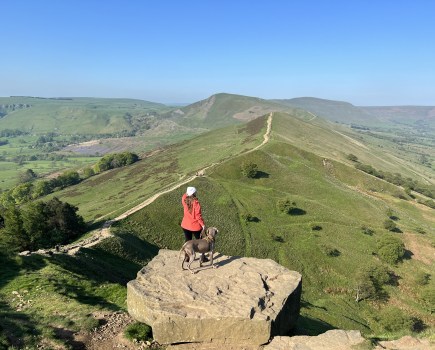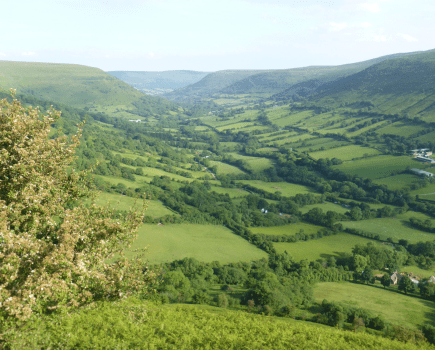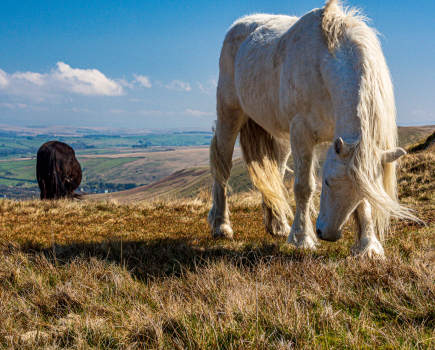John Gilham finally completes the Farleton Knott walk
So many times I had motored along the M6 north of Lancaster and past that beautiful little limestone knoll. Each time I did so I vowed to climb it. With fantastic form, fine screes and tiered crags it just had to be done – one day. But Farleton Knott kept getting forgotten like a New Year’s Resolution, forsaken for some higher Lakeland mountain. Fast forward to 2013. When I finally succeeded in climbing it, the walk I chose was 20km/12.5 miles in length, involved 550m/1750ft of ascent, and took about 6 hours.
What’s left of my hair is grey, but I’m finally here on the summit looking down on motorists speeding by. Maybe the man in that fast black BMW will be up here in 20 years, or the family in that VW campervan? The view is magnificent and encompasses the peaks of the Lake District on the far shores of Morecambe Bay, the silky smooth humps of the Howgills flanked by Ingleborough, the Middleton Fells, and the long Bowland ridges, which stretch across the southern horizon. Here are some of the best-preserved limestone pavements in Britain, one of the reasons both Hutton Roof Crags and Farleton Knott have been designated SSSIs. The rare rigid buckler-fern, scented Solomon’s seal, limestone fern, and dark red helleborine are all to be seen on the pavements.
Looking for another quieter walk? These two walks from Edale explore the quieter side of Kinder.
The first thing you need to know about Farleton Knott and its neighbour Hutton Roof Crags is that there are a myriad secretive little footpaths weaving through the scrub woodland and across limestone. Few of these are marked on OS maps, so if you’ve got a GPS it would be of great help.
Views of Ingleborough
The day had started at Dalton Crags to the east of Burton-in-Kendal and a path had led Nicola and me through woodland up to the summit of Hutton Roof Crags. Here the trig point is set among grasslands interspersed with bracken and hawthorn. Farleton Knott dominates the western skyline while Ingleborough rules the east. A little path led us uncertainly through the bracken then past more interesting limestone crags and pavements into the woods, where ash and hazel shut out all but flickers of sunlight. Moss-covered limestone lined the leafy path across an area known as Potslacks. We emerged onto open fell close to the road that separates Hutton Roof Crags and Farleton Knott.
We decided, well no, I decided, that to walk Farleton Knott without seeing that western façade would be to miss one of the great views so, rather than going straight for the summit, we followed the bridleway traversing the south side. Easy walking on the Lancaster Canal brought us that view but made it even more exquisite with the waterside in the foreground. From here I could see that there are scree runs and little paths, but they were far too steep for comfort and users were despoiling those screes.
Newbiggin Crags
We made our approach from the north, near Aikbank Farm. An old mine track raked up to the brow of the fell, where we could see a clear easy way on a grass ridge to the summit. After traversing the limestone plateau to Newbiggin Crags we were back at the road a little further east than we crossed it last time. From here we returned to Hutton Roof Crags. Looking at the Explorer map you see the green dashes of the Limestone Link route but in reality the path you’ll find yourself on is a short way south, marked by black dashes. It traverses Uberash Plain in fine fashion, undulating over slopes covered in places with blue moor grass before threading through more scrub woodland and juniper thickets. We found scores of different butterflies – several sorts of fritillaries on the orchids and saw-worts, and also common blues, graylings and brimstones. To Nicola’s delight we also found raspberry canes, with delicious ripe fruit.
The single most spectacular feature of the fell is the line of climbers’ crags known as the Rakes, which suddenly appears as the path descends towards the village of Hutton Roof. Today a party of schoolchildren, who were in good voice and very excited, were pitting their skills against the rockfaces. Peace returned on reaching the idyllic village below.
The last stretch of the walk is an easy one on a farm track followed by field paths and we were grateful for this. In late evening light we made our way back to the car with just one regret – there were no more raspberries.
ROUTE DESCRIPTION
- Take the R exit at back of car park. Path climbs into woods, up steps and through gate before winding uphill through gate near wall corner to reach summit of Hutton Roof Crags.
- Take the R fork NE through bracken. Turn L through scrub woodland.
- Turn L on Potslacks path heading NW to lane at GR 550787.
- Follow track opposite to reach low crags. Turn L across field, then along stony track beside Holme Park Quarry to A6070.
- Turn R, then L to Lancaster Canal. Head N on towpath. Turn L on field path beside M6 and R on lane across motorway back to towpath. Follow this to Kiln Hall.
- Follow lane over bridge, turn L by hall, then fork R.
- At T-junction take track raking R up hillside. When crags of Farleton Knott appear take one of several useable tracks to W skyline. Turn L to summit cairn.
- Follow path SE to and then L alongside tall wall. Go through gate in wall corner and maintain direction. The path eventually curves R to meet Holme Park bridleway. Turn L to laneside gate (GR 552789).
- Continue on signed path staggered R across road. Traverse scrub woodland of Uberash Plain. Descend to foot of the Rakes (crags), round them to L and descend to road at Hutton Roof.
- Turn R then R again along Lowther Court’s drive. Follow unsurfaced lane bending L beneath Park Wood. Waymarked path diverts from track and continues SW across fields. Angle L below farmhouse to reach gate by road. Turn R back to start.
Photo: Shutterstock






